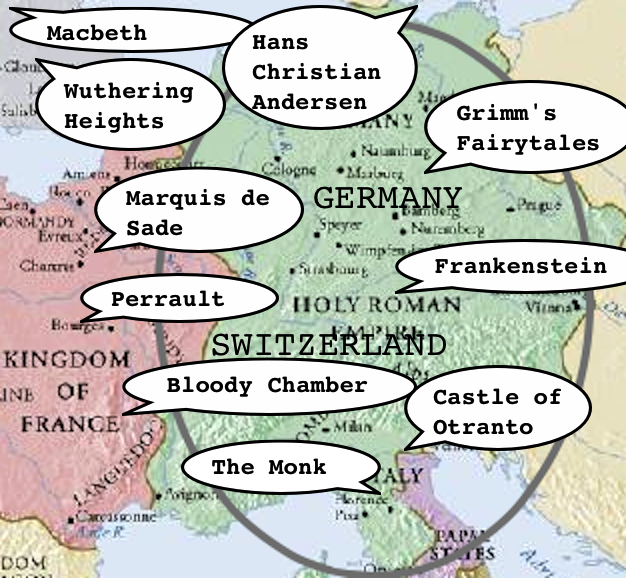Setting

The Monk by Matthew Lewis (1796) had to be revised due to scandalous content. It’s set in medieval Italy, just like Otranto and its main character is a villainous monk. A modern(ish) critic sums it up: the fourth edition now, ‘contains nothing which could endanger the most fragile virtue… [Lewis] expunged every remotely offensive word in his three volumes, with meticulous attention to lust. Ambrosio, formerly a ravisher, becomes an intruder or betrayer; his incontinence changes to weakness or infamy, his lust to desire, his desires to emotions. Having indulged in excesses for three editions, he committed an error in the fourth,’ Peck, Louis (1961) A Life of Matthew G. Lewis. Cambridge, MA: Harvard University Press. p. 34-35.
Frankenstein, or, the Modern Prometheus, (1818) was conceived by Mary Shelley in Italy, but is set in Switzerland and the frozen wastelands of the north. Its theme is hubris, and it is one of the first Science Fiction novels written, dealing with the dangerous power of scientific discovery. This makes it very different to the pseudo-medieval novels, as it is forward-looking, dealing with the cutting edge of science at the time, in galvanism, anatomy and the most modern philosophical thought about the status and rights of man.
The Gothic in Architecture was a response to the anxieties of the incipient Industrial and Scientific revolutions that picked up pace in the mid eighteenth century. This shift was as traumatic as it was violent. People did not want to be catapulted into a dangerous, unknown future. They wanted the security, romance and magical qualities of the past. Architecture began to copy much older, medieval styles.
Here’s a fun game you can play: it’s called spot the difference between buildings made in 1100, and those whipped up eight hundred years later. Check out the photos below.
The Gothic in Art
Francisco Goya (1746 – 1828) offers visionary works of horrific and nightmarish proportions which come to embody the supernatural and macabre in the human psyche and the human world.
William Blake (1757 – 1827) overtly challenges the political, monarchic and religious establishment in his work which seeks to expose the oppressive nature of rationalism and reinstate the liberty of the mind.
The Gothic In Poetry
Robert Blair (1699 – 1746) also dwelt on themes of death and darkness, and in this sense subscribed to the gothic movement. The influence of the gothic on poets in the Romantic Period is also clear. The ballad style is an ancient ‘folk style’ of storytelling reinvigorated by the romantics to expound gothic ideas and themes. Samuel Taylor Coleridge’s (1772 – 1834) The Rime of the Ancient Mariner (1798) as well as Christabel (1816) both contain gothic ideas expressed in the ballad style. ‘La Belle Dame sans Merci‘ (1820) by John Keats is another example to consider.
Gothic Themes:
- A fascination for the past, often but not exclusively, the Medieval era. The past is associated with simplicity and harmony in contrast to the turmoil of modernity.
- An interest in the supernatural, eccentric, magical, sublime, where ‘supernatural’ means something beyond nature and beyond the rational.
- Developed characterisation, often psychological.
- A focus on the sinister, dark, horrific and terrible.
- Grand settings, or conversely, simple settings (‘domestic’ gothic). Ruins, dungeons, castles, darkness, wilderness, heavy weather etc.
- ‘It was Gothicism, with its formality, codification, ritualistic elements and artifice that transformed the old folk tale of terror into the more modern horror story,’ Bloom, Clive (2010) Gothic Histories: The Taste for Terror 1764 to the Present p 2-3






